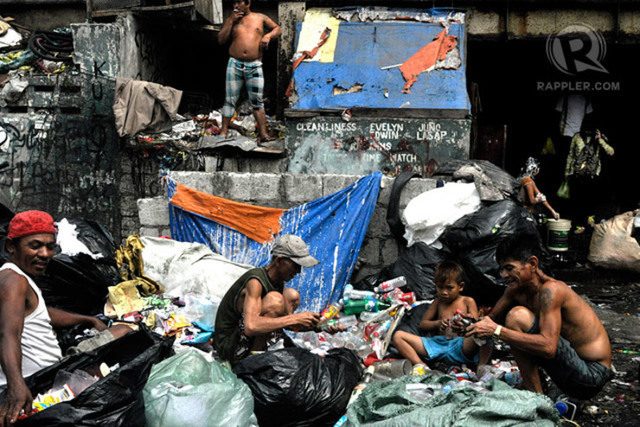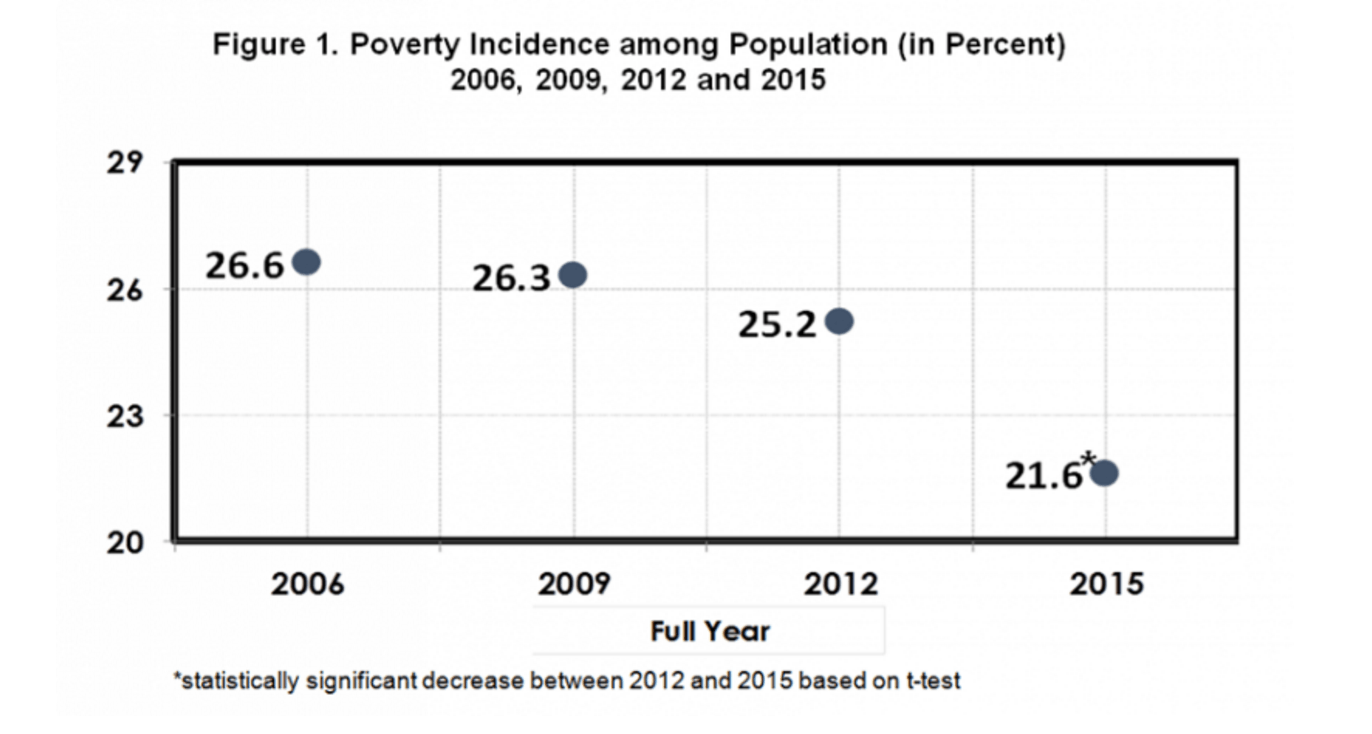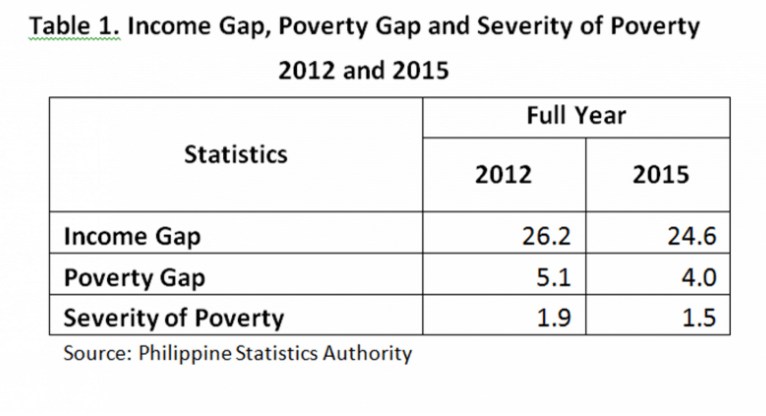SUMMARY
This is AI generated summarization, which may have errors. For context, always refer to the full article.

MANILA, Philippines – Consistent economic growth coupled with expanded social policies have been able to make a noticeable dent in poverty in the last 3 years, according to the National Economic and Development Authority (NEDA).
Data from the Philippine Statistics Authority (PSA) released Thursday, October 27, showed that the country’s poverty incidence for 2015 declined to 21.6%, from 25.2% in 2012 and 26.3% in 2009.
That means there were about 1.4 million less poor Filipinos in 2015 than in 2009, according to NEDA.
“We are pleased to note that this is within the target set in the current Philippine Development Plan of 20.0% to 23.0% for the year and has resulted from a generally low and stable inflation, improved incomes, and higher employment rates in the period,” said NEDA Deputy Director General Rosemarie Edillon in a statement.

Edillon noted, however, that the rate of poverty reduction could have been faster between 2012 and 2015 if not for major shocks, especially typhoons and the El Niño phenomenon, which hurt agricultural production, affected rural incomes, and drove up food prices due to shortages.
The data showed that the decrease in poverty incidence was observed in all regions. But from 2012 to 2015, the largest drop in poverty incidence was recorded in the Davao Region and Soccsksargen, which saw a reduction of 8.7 and 7.4 percentage points (ppt), respectively.
Edillon also noted that the poverty incidence in Calabarzon now stands at a single-digit level for the first time, at 9.1%.
Accelerating poverty reduction
In recent years, the rate of poverty reduction has been accelerating. Among families, poverty incidence was at a record low of 16.5% in 2015, versus 19.7% in 2012 and 21.0% in 2006.
Data also showed that the magnitude of the reduction in poverty incidence improved between 2012 and 2015, falling by 3.6 ppt compared to just 1.1 ppt between 2009 and 2012.
In addition, the subsistence incidence, which measures extreme poverty, was reduced by more than half as of 2015, enabling the country to meet a Millennium Development Goal.
“This signifies improvements in the quality of living conditions, which may indicate that the government’s programs and projects, such as the Conditional Cash Transfer Program, have been gaining traction,” Edillon said.
She credited the broader implementation of the Conditional Cash Transfer Program or the Pantawid Pamilyang Pilipino Program (4Ps) in particular, noting that its budget increased by 194.1% from P21.2 billion in 2011 to P62.3 billion in 2015.
This resulted in a 91.3% growth in terms of coverage from 2.3 million families in 2011 to 4.4 million in 2015.
Growing income, lower inflation
The Philippines has been one of the fastest growing economies in the world, averaging 6.2% gross domestic product (GDP) growth in 6 years.
The chief agent of poverty reduction, however, is measured in per capita income, or the average income an individual or household makes.
Based on PSA data, the nominal per capita income of the bottom 3 deciles of households grew significantly by 24.3% from 2012 to 2015.
Edillon pointed out that this growth was even faster compared to the average for all income groups and including those in the top 20% income group, which grew by 15.8% and 12%, respectively.
This was helped by low inflation during the period, with consumer price inflation decreasing from 12.1% in 2009-2012 to 9.5% in 2012-2015.
Inflation was also moderate for the lower income segment as inflation among the bottom 3 deciles slowed from 12.0% in 2009-2012 to 11.7% in 2012-2015 despite higher food prices, particularly for the staple, rice.

More to be done
Despite the encouraging numbers, Edillon said more work needs to be done, particularly in reducing inequality across regions and sectors, especially in the Autonomous Region in Muslim Mindanao (ARMM) and Eastern Visayas which posted the highest poverty incidence rates.
“Man-made shocks, mostly arising from armed conflict, can be addressed by the current efforts to attain lasting peace, along with deliberate strategies to bridge the development gap,” she said.
Since both the ARMM and Eastern Visayas are vulnerable to natural shocks, Edillon said “a mechanism to accelerate relief and then recovery and rehabilitation efforts following a calamity also needs to be put in place immediately.”
The NEDA official also noted that the underemployment rate still tends to be steep, signaling the low earning capacity of the poor and their limited access to regular and productive jobs.
Easing restrictions on foreign investments, she said, could help improve the business climate and boost job creation.
On the agricultural front, “shifting policies to place emphasis on food security rather than self-sufficiency could help reduce food prices, particularly of rice,” said Edillon.
“This should be accompanied, however, by appropriate safety nets for farmers who may be potentially displaced,” she added.
For the medium term, NEDA aims to cut poverty incidence to between 13% and 15% by 2022. The agency is also crafting the next Philippine Development Plan for 2017-2022 which will be aligned with the long-term vision of Ambisyon Natin 2040.
“There is still so much work to be done but we have already begun to lay a strong foundation for the kind of development we want that will enable every Filipino family to enjoy a matatag, maginhawa, at panatag na buhay (stable, prosperous, and peaceful life),” Edillon said. – Rappler.com
Add a comment
How does this make you feel?
There are no comments yet. Add your comment to start the conversation.